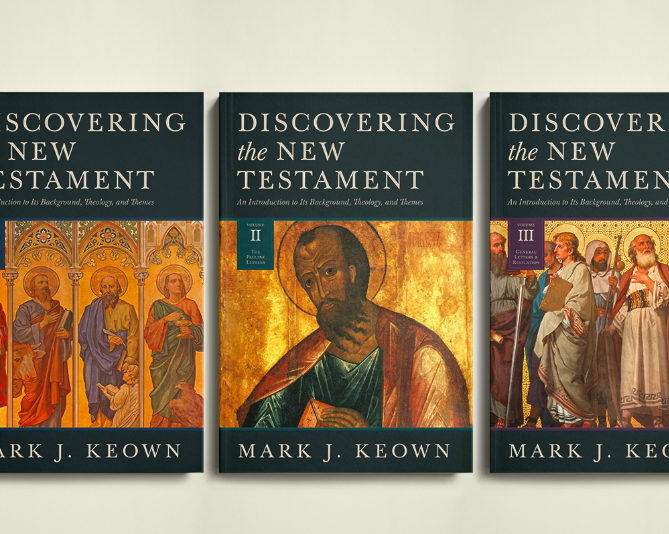Lexham Press is a relatively new publisher that has been producing some great works. Honestly, there were only a few books I wanted from them a few years ago. Today, my list of books to request is too long. One great book (the first in a series of three) is Discovering the New Testament by New Zealand’s Mark Keown. Keown just published a large two-volume commentary on Philippians in the Evangelical Exegetical Commentary (EEC) series by Lexham Press. For a NT letter made up of four chapters, these two commentaries combined are over 1,000 pages. How Keown found time to write those volume, these three volumes (which will certainly be over 1,000–probably above 2,000–pages), and more is beyond me. Not only that, but the content is solid.
For Keown, the “center of the Biblical narrative, God’s story of salvation, is Christ” (1). He writes, “The letters of the New Testament [as well as the Old] then must be read in light of Christ, always pointing us to Christ and what he means for us, for the church, for life, and for everything!” (1). After briefly looking at the formation of the NT, Keown spends two chapters on the Jewish and Greco-Roman context of the NT, looking at the life and writings of those cultures. Understanding patronage and honor in shame, the different religions and philosophies, and the imperial cult (worship of the emperor) in the Greco-Roman culture is crucial. Understanding the geography, cultural influences, how often Israel had been occupied by other nations (and still was being occupied by Rome), what the Jewish people thought about their covenant with God, angels and demons, the apocalypse, the temple, and more… is necessary to understanding the NT.
He gives two helpful chapters critical methodologies and how the Synoptics are related to one another. He briefly and easily explains the different criticisms such as textual, historical, source, form, redaction, rhetorical, and narrative criticism, as well as the three quests for the historical Jesus. This is a short chapter that is easy to read to understand what these different methods are.
Because of Robert Stein’s BECNT Mark commentary, I had viewed redactional criticism pretty negatively. But Keown writes that “it was the development of redactional criticism that saw the rise of evangelical biblical studies in the mid- to late twentieth century” (104). Evangelical scholars would note the differences between the Synoptics to understand the theology each writer was “trying to impart” to their readers (105). The Gospel writers weren’t making things up; they simply had a particular perspective about Jesus they wanted to teach all of their readers. Keown then looks at the proposed hypotheses over Gospel sources and how they are related to each other. Did Matthew use Mark and Luke? Luke use Mark and Matthew? Matthew and Luke use Mark and Q? In 17 pages Keown guides his readers easily through what is often a dense discussion.
Keown gives 190 pages to the four Gospels and Acts. Biblical introductions take many forms. David deSilva looks at the social, narrative, and rhetorical structure of each NT letter. The Cradle, the Cross, and the Crown has a unit-by-unit discussion (more or less a summary of each NT letter). In these five chapters Keown looks at the questions of authorship, date, provenance, setting, audience, sources, textual issues, structure, context, purpose, etc. (Not every question is covered in each chapter, but many are.) Keown then looks at the different emphases in each Gospel and in Acts. For example, Luke focuses on hospitality, discipleship, the marginalized and oppressed, prayer, salvation history, and more. Acts focuses on prayer, baptism, the Holy Spirit, the church, hospitality and communion, persecution, the expansion of the gospel, etc. Each chapter is packed with information, and should lead you to begin marking up your Bible so that as you read through these books in the future you can remember and make new connections.
The final three chapters center on the kingdom of God. The first covers what the kingdom of God is, then the power of the kingdom (seen in Jesus’ miracles), and then the teaching of the kingdom (seen in Jesus’ parables). The kingdom of God “is found where the people of God are and [where?] the work of God by his Spirit [is?] across all of creation” (457). The church is not the kingdom, but the church represents the kingdom. They show the world what the kingdom of God looks like: it is “a community of love and unity where God is honored, and people [are] living as he intended” (458). That is, of course, the ideal, which, of course, does not always happen. However, even in our weak and frail state, God is glorified and he works.
Recommended?
Yes. Keown has written a fantastic NT introduction, and it’s only the first volume. I expect as much quality in the next two volumes as found here. One should buy the two introductions mentioned above as well as Keown’s. You can have too many NT introductions, but you can’t have too many good NT introductions. (There are a lot of simplistic, outdated intros out there). Come and re-discover the NT all over again. Great for those in college, Bible college, and seminary.
Lagniappe
- Author: Mark Keown
- Hardcover: 632 pages
- Publisher: Lexham Press (October 31, 2018)
Find it on Amazon!
Disclosure: I received this book free from Lexham Press. The opinions I have expressed are my own, and I was not required to write a positive review. I am disclosing this in accordance with the Federal Trade Commission’s 16 CFR, Part 255 http://www.access.gpo.gov/nara/cfr/waisidx_03/16cfr255_03.html.
Amazon Affiliate Disclosure: As an Amazon Associate I earn from qualifying purchases.


